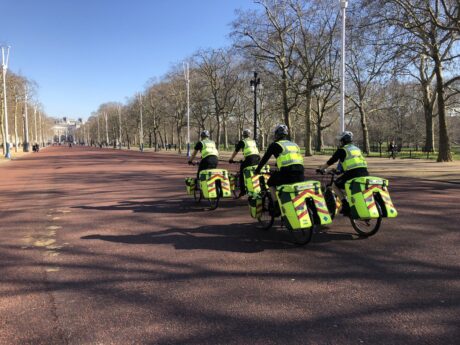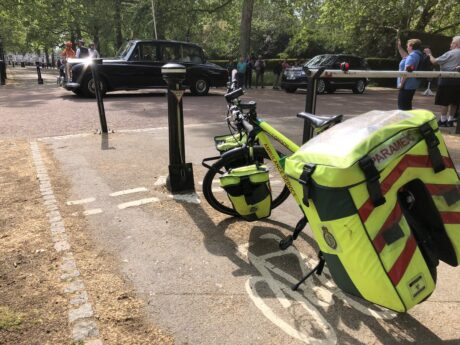Cycle responder
Cycle responders are experienced frontline paramedics, fully trained to work on their own and operate in busy areas that are difficult to travel through in a car or ambulance.
Our cycle response unit of 40 paramedics on bikes can get through narrow streets, pedestrian areas and shopping centres very easily.
They are able to reach patients quickly and start to give life-saving treatment while an ambulance is on the way.
Our cycle responders have equipment designed to enable them to respond to emergency calls: a custom-built bicycle, medical kit and specialist clothing.
They respond to emergency calls in particularly congested areas of the capital such as the West End, Heathrow Airport, Kingston town centre, the City of London and St Pancras.
Custom-built bicycle
Cycle responders use custom-built Specialized Rockhopper mountain bikes fitted with blue lights and a siren. The bikes are lightweight and include a strengthened back wheel and stronger spokes, puncture-proof tyres, lights, pannier bags and water bottles.
Medical kit
Our cycle responders’ kit is very similar equipment to that found on the ambulances, fast response cars and motorcycle response units (MRU). It includes, among other things: a defibrillator (used to re-start a patient’s heart if they go into cardiac arrest), oxygen, entonox (commonly known as gas and air), a pulse monitor, a blood pressure monitor, adult and child bag and mask resuscitators, adrenaline, aspirin, asthma and diabetes drugs, bandages and dressings, rubber gloves, and cleanser.
Specialist clothing
Their specially-designed uniform includes: helmet, gloves, glasses, reflective jacket/jerseys, trousers (shorts for warmer weather), waterproofs, cycle shoes, base layers, padded undershorts, skull cap, anti-pollution mask, protective body armour, utility belt, a radio, and mobile phone with Bluetooth headset.
Facts about the cycle response unit:
- Cycle responders attend nearly 17,000 calls a year.
- They resolve over 50 per cent of all incidents at the scene.
- Their average response time to calls is six minutes.
- They can cycle 20-30 miles in a single 10 – 12 hour shift.

Follow us on social media: